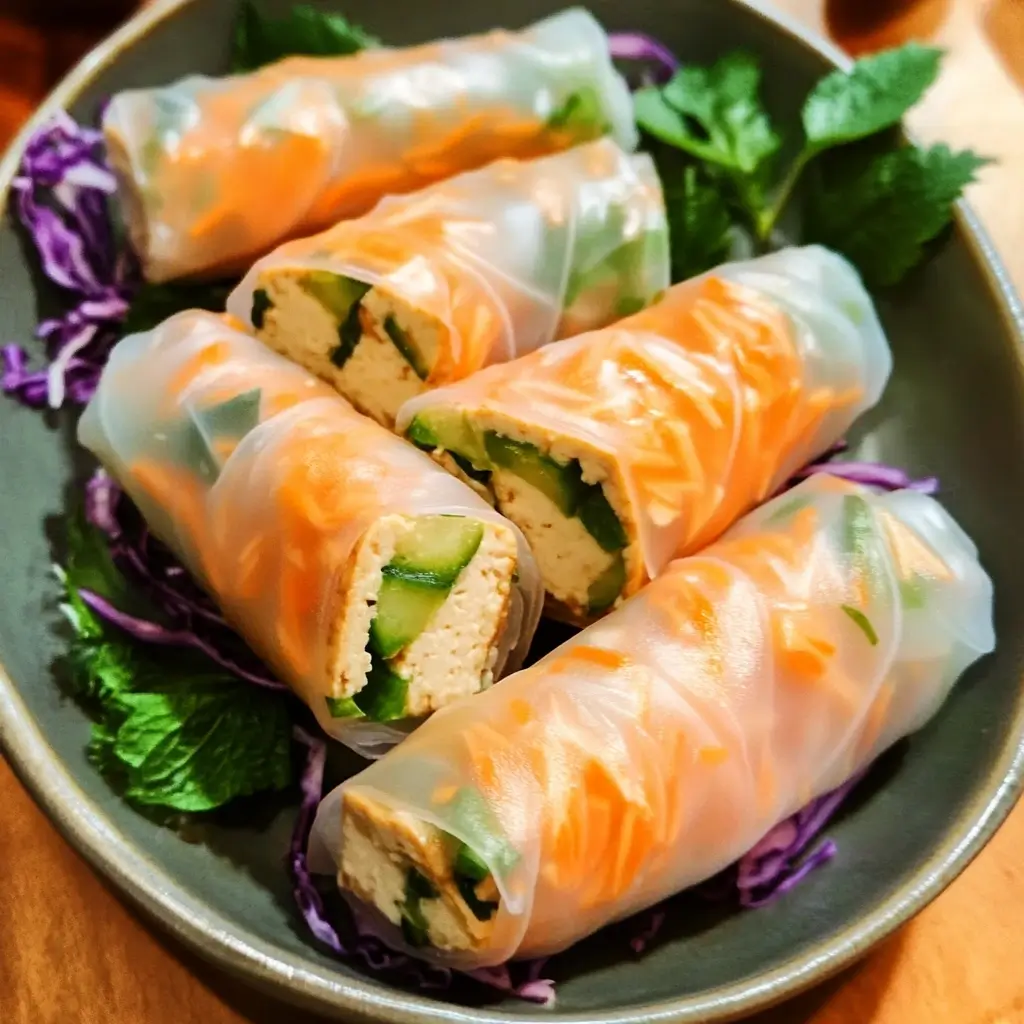Our household has a bit of a love affair with anything that can be customized, and these Tofu Rice Paper Rolls have become an absolute sensation, especially on warm evenings or when we’re craving something light yet satisfying. The first time I made them, I was a little nervous about the rolling technique, but it’s surprisingly forgiving! My kids, who can be notoriously picky about vegetables, actually get excited to pick their own fillings and attempt (with varying degrees of success) to roll their own. The vibrant colors, the fresh crunch, and that utterly addictive peanut dipping sauce just make it a winner every single time. It’s become our go-to for a healthy, fun, and interactive meal that leaves everyone feeling good. Plus, they look so impressive when we have guests, who are always amazed at how simple they are to prepare once they see the process.
Ingredients
Here’s what you’ll need to create these delightful and refreshing Tofu Rice Paper Rolls, along with a rich and creamy peanut dipping sauce.
For the Tofu & Marinade:
- 1 block (14-16 oz) extra-firm tofu: Pressed for at least 30 minutes to remove excess water, then patted dry and cut into thin strips or small cubes. This ensures a chewier texture and better flavor absorption.
- 2 tablespoons soy sauce (or tamari for gluten-free): Adds a savory, umami depth to the tofu.
- 1 tablespoon rice vinegar: Provides a subtle tanginess that brightens the marinade.
- 1 teaspoon sesame oil: Imparts a nutty aroma and flavor.
- 1 teaspoon maple syrup or agave nectar (optional): For a touch of sweetness to balance the savory notes.
- 1/2 teaspoon garlic powder: For a convenient garlicky kick.
- 1/2 teaspoon ginger powder (or 1 tsp fresh grated ginger): Adds a warm, zesty spice.
- 1 tablespoon neutral cooking oil (like avocado or canola oil): For pan-frying the tofu to golden perfection.
For the Rice Paper Rolls:
- 10-12 sheets of rice paper (22cm or 8.5-inch diameter): These are the translucent wrappers that hold all the delicious fillings.
- 4 oz rice vermicelli noodles: Fine, delicate noodles that add a lovely soft texture.
- 1 large carrot: Peeled and julienned or grated, for sweetness and crunch.
- 1 cucumber: Julienned, seeds removed if particularly watery, for a refreshing coolness.
- 1 red bell pepper: Thinly sliced, adding vibrant color and a sweet crispness.
- 1 cup shredded lettuce (like romaine or butter lettuce): Forms a soft bed for the other ingredients.
- 1/2 cup fresh mint leaves: Adds a burst of cool, aromatic freshness.
- 1/2 cup fresh cilantro leaves: Provides a distinctive, bright herbal note (can be omitted if you’re not a fan).
- 1/4 cup fresh Thai basil leaves (optional): Offers a slightly spicy, anise-like flavor that is authentically delicious.
For the Peanut Dipping Sauce:
- 1/2 cup creamy peanut butter: The base of our rich and nutty sauce.
- 1/4 cup warm water: To thin the sauce to the desired consistency.
- 2 tablespoons soy sauce (or tamari): For that essential savory flavor.
- 1 tablespoon rice vinegar: Adds a balancing tang.
- 1 tablespoon maple syrup or agave nectar (or honey if not strictly vegan): For sweetness.
- 1 tablespoon lime juice (freshly squeezed is best): Brightens the sauce with a zesty kick.
- 1 teaspoon sesame oil: Enhances the nutty flavor profile.
- 1 clove garlic, minced (or 1/2 tsp garlic powder): For aromatic depth.
- 1/2 teaspoon grated fresh ginger (or 1/4 tsp ginger powder): Adds a warm spice.
- 1/2 teaspoon sriracha or a pinch of red pepper flakes (optional): For a touch of heat, adjust to your preference.
Instructions
Follow these step-by-step instructions to assemble your beautiful and tasty Tofu Rice Paper Rolls. Preparation is key, so having all your components ready (“mise en place”) will make the rolling process smooth and enjoyable.
1. Prepare the Tofu:
* After pressing the tofu, cut it into thin strips, about 1/4-inch thick and 2 inches long, or small cubes.
* In a shallow dish or bowl, whisk together the tofu marinade ingredients: soy sauce (or tamari), rice vinegar, sesame oil, maple syrup (if using), garlic powder, and ginger powder.
* Add the tofu strips to the marinade, gently tossing to ensure each piece is coated. Let it marinate for at least 15-20 minutes at room temperature, or up to an hour in the refrigerator for deeper flavor.
* Heat the 1 tablespoon of neutral cooking oil in a non-stick skillet or wok over medium-high heat.
* Once the oil is shimmering, carefully add the marinated tofu in a single layer (you may need to do this in batches to avoid overcrowding the pan).
* Cook for 3-5 minutes per side, until golden brown and slightly crispy. Remove from pan and set aside to cool slightly.
2. Cook the Rice Vermicelli Noodles:
* Bring a small pot of water to a boil. Add the rice vermicelli noodles and cook according to package directions, usually about 3-5 minutes, until tender.
* Drain the noodles immediately and rinse them under cold running water to stop the cooking process and remove excess starch. This prevents them from clumping together. Set aside.
3. Prepare the Vegetables and Herbs:
* Wash and prepare all your vegetables and herbs as listed in the ingredients: julienne or grate the carrot, julienne the cucumber, thinly slice the red bell pepper, shred the lettuce, and pick the mint, cilantro, and Thai basil leaves from their stems.
* Arrange all prepared fillings on a large platter or in separate bowls for easy access during assembly. This creates an inviting “rolling station.”
4. Make the Peanut Dipping Sauce:
* In a medium bowl, combine the creamy peanut butter, warm water, soy sauce (or tamari), rice vinegar, maple syrup, lime juice, sesame oil, minced garlic, grated ginger, and sriracha (if using).
* Whisk vigorously until the sauce is smooth and creamy. If it’s too thick, add a little more warm water, one teaspoon at a time, until you reach your desired consistency. It should be pourable but still thick enough to coat the rolls.
* Taste and adjust seasonings if needed – more soy for saltiness, lime for tang, syrup for sweetness, or sriracha for heat. Set aside.
5. Assemble the Rice Paper Rolls:
* Fill a large, shallow dish (a pie plate or a large dinner plate with a lip works well) with warm water – not too hot, or the rice paper will become too delicate too quickly.
* Set up your rolling station: have the prepared tofu, noodles, vegetables, herbs, and the dish of warm water within easy reach. You’ll also need a clean, damp cutting board or a smooth, clean work surface to roll on. Some people prefer a damp, clean kitchen towel.
* Take one sheet of rice paper and submerge it completely in the warm water for about 15-30 seconds, or until it becomes soft and pliable. It should still have some slight firmness; it will continue to soften as you work.
* Carefully lift the softened rice paper from the water, letting excess water drip off, and lay it flat on your damp work surface.
* Arrange your fillings in the lower third of the rice paper, closest to you, leaving about an inch border on the sides. A common layering order is:
* A few lettuce leaves as a base.
* A small bundle of rice vermicelli noodles.
* A few strips of the cooked tofu.
* Strips of carrot, cucumber, and red bell pepper.
* A sprinkle of mint, cilantro, and Thai basil leaves.
* Important: Don’t overfill the roll, or it will be difficult to wrap and prone to tearing.
* To roll:
* Fold the bottom edge of the rice paper up and over the fillings, tucking it in snugly.
* Fold in the left and right sides of the rice paper towards the center, over the filling (like an envelope).
* Continue rolling from the bottom up, keeping the roll tight and compact, until it’s completely sealed. The rice paper will stick to itself.
* Place the finished roll on a separate plate or platter, seam-side down. Make sure the rolls aren’t touching each other directly at first, as they can stick together. You can place them on a piece of parchment paper or a lightly oiled plate if making many.
* Repeat the process with the remaining rice paper sheets and fillings until all ingredients are used.
6. Serve:
* Serve the Tofu Rice Paper Rolls immediately with the prepared peanut dipping sauce on the side.
Nutrition Facts
- Servings: This recipe typically makes 5-6 servings (2 rolls per serving).
- Calories per serving (approximate for 2 rolls + sauce): Around 350-450 calories.
- Protein: Approximately 15-20g. Primarily from the tofu and peanut butter, crucial for muscle repair and satiety.
- Fiber: Approximately 6-8g. High in fiber from vegetables and whole ingredients, aiding digestion and promoting fullness.
- Healthy Fats: Primarily unsaturated fats from peanut butter and sesame oil, beneficial for heart health.
- Vitamins & Minerals: Rich in Vitamin A (from carrots), Vitamin C (from bell peppers and lime), and various B vitamins.
- Low Saturated Fat: When using lean tofu preparation methods, these rolls are relatively low in unhealthy saturated fats.
Disclaimer: Nutritional information is an estimate and can vary based on specific ingredient choices and portion sizes.
Preparation Time
- Prep Time (Tofu, Vegetables, Noodles): 45-60 minutes (includes tofu pressing and marinating time, chopping vegetables, and cooking noodles).
- Cook Time (Tofu): 10-15 minutes.
- Assembly Time (Rolling): 20-30 minutes (depending on your speed and experience with rice paper).
- Total Time: Approximately 1 hour 15 minutes to 1 hour 45 minutes.
This recipe is ideal for a weekend lunch or a weekday dinner when you have a bit more time to dedicate to the enjoyable process of preparation and assembly. The active “hands-on” time is spread out, making it feel less daunting.
How to Serve
Tofu Rice Paper Rolls are incredibly versatile and can be served in various delightful ways:
- As a Light Lunch or Dinner:
- Serve 2-3 rolls per person as a complete, refreshing meal.
- Accompany with a small bowl of the peanut dipping sauce for each individual.
- A side of edamame or a light miso soup can complement the meal beautifully.
- As an Appetizer or Starter:
- Cut each roll in half diagonally for easier handling and an appealing presentation.
- Arrange the halves on a platter with a central bowl of dipping sauce.
- Perfect for parties, gatherings, or as a prelude to a more substantial Asian-inspired main course.
- For a “Build-Your-Own” Bar:
- This is a fantastic interactive option for families or casual get-togethers.
- Lay out all the prepared fillings (tofu, noodles, various vegetables, herbs) in separate bowls.
- Provide a stack of softened rice paper sheets (one at a time, or keep them in warm water for guests to grab).
- Let everyone assemble their own rolls according to their preferences. It’s fun and caters to different tastes and dietary needs.
- Garnishes and Extra Sauces:
- Garnish the serving platter with extra fresh mint, cilantro, lime wedges, and perhaps some toasted sesame seeds sprinkled over the sauce.
- Offer alternative dipping sauces alongside the peanut sauce for variety, such as:
- Sweet chili sauce (store-bought or homemade)
- Hoisin-based dipping sauce (hoisin mixed with a little water, lime juice, and a touch of sriracha)
- Nuoc Cham (Vietnamese dipping sauce – for a non-vegan option or a vegan adaptation)
- Presentation Tips:
- The vibrant colors of the fillings are naturally appealing. Try to arrange fillings so different colors are visible through the translucent rice paper.
- If cutting rolls in half, use a very sharp, slightly wet knife to get a clean cut without tearing the rice paper.
- Serve immediately after rolling for the best texture, as rice paper can dry out or become too chewy if left sitting for too long.
Additional Tips
To ensure your Tofu Rice Paper Roll experience is a resounding success, consider these helpful tips:
- Don’t Over-Soak the Rice Paper: A common mistake is leaving the rice paper in warm water for too long. It should be pliable but not overly limp when you take it out. It will continue to soften as you add fillings. Aim for 15-30 seconds.
- Work on a Damp Surface: A slightly damp, clean cutting board or even a damp, clean tea towel can prevent the rice paper from sticking too much and make rolling easier. Avoid overly wet surfaces.
- Mise en Place is Your Best Friend: Have ALL your ingredients (tofu, noodles, chopped vegetables, herbs) prepped and arranged before you start soaking your first rice paper. This makes the assembly line smooth and stress-free.
- Don’t Overstuff the Rolls: It’s tempting to load them up, but overfilling makes rolling difficult and increases the chances of the rice paper tearing. Start with less filling than you think you need; you’ll get a feel for the right amount after a couple of rolls.
- Roll Tightly but Gently: You want a firm roll so it holds its shape, but don’t pull so hard that you tear the delicate rice paper. Tuck the initial fold snugly over the fillings, then continue rolling with even pressure.
- Vary Your Fillings: Feel free to get creative! Other great additions include thinly sliced avocado, mango strips for sweetness, pickled daikon or carrots for tang, cooked shrimp (if not vegan), or even other cooked proteins like shredded chicken or tempeh.
- Sauce Customization: The peanut sauce is classic, but don’t be afraid to adjust it to your liking. More lime for tang, more sriracha for heat, a little water for a thinner consistency, or even a dash of fish sauce (if not vegan/vegetarian) for extra umami.
- Best Eaten Fresh: Rice paper rolls are truly at their best when freshly made. The rice paper can become tough or dry out if made too far in advance. If you must make them ahead, cover them with a damp paper towel and plastic wrap and store them in the refrigerator for no more than a few hours. Let them come to room temperature slightly before serving.
FAQ Section
Q1: Is this Tofu Rice Paper Roll recipe vegan?
A1: Yes, as written, this recipe is entirely vegan. Ensure your soy sauce is purely plant-based (most are) and use maple syrup or agave nectar instead of honey in the sauce. Tofu is a fantastic plant-based protein source.
Q2: Are these rice paper rolls gluten-free?
A2: Yes, they can easily be made gluten-free. Rice paper, rice vermicelli noodles, and most fresh ingredients are naturally gluten-free. The key is to use tamari instead of regular soy sauce in both the tofu marinade and the peanut dipping sauce, as tamari is typically brewed without wheat. Always double-check labels.
Q3: My rice paper keeps tearing! What am I doing wrong?
A3: This is a common issue! Reasons include:
* Over-soaking: The paper becomes too fragile. Reduce soaking time.
* Water too hot: Use warm, not hot, water.
* Overfilling: Too many fillings stretch and tear the delicate paper.
* Dry work surface: The paper might stick and tear when you try to roll. Use a damp surface.
* Sharp fillings: Be mindful if using ingredients with sharp edges; try to cushion them with softer items like lettuce.
Practice makes perfect!
Q4: Can I make Tofu Rice Paper Rolls ahead of time?
A4: While they are best enjoyed fresh, you can make them a few hours ahead. To prevent them from drying out or sticking together, place them on a platter without touching each other, cover them with a slightly damp paper towel, and then wrap the platter tightly with plastic wrap. Store in the refrigerator. Let them sit at room temperature for about 15-20 minutes before serving to improve the texture of the rice paper. The peanut sauce can be made a day or two in advance and stored in an airtight container in the fridge.
Q5: What’s the best kind of tofu to use for rice paper rolls?
A5: Extra-firm tofu is highly recommended. It holds its shape well during pressing, marinating, and cooking, and has a meatier texture. Firm tofu can also work, but you’ll need to be more diligent with pressing to remove excess water. Avoid silken or soft tofu, as they will fall apart.
Q6: Can I use other proteins besides tofu?
A6: Absolutely! Cooked shrimp are a classic addition. Shredded cooked chicken, thinly sliced cooked pork, or even tempeh (prepared similarly to the tofu) would also work wonderfully. For a fully vegetarian/vegan alternative to tofu, you could use edamame or baked/fried chickpeas.
Q7: How can I make these rice paper rolls more kid-friendly?
A7: The “build-your-own” approach mentioned in “How to Serve” is perfect for kids, as they can choose only the fillings they like. You might also want to:
* Cut vegetables into smaller, more manageable pieces.
* Offer milder herbs or let them skip herbs if they are sensitive.
* Ensure the peanut sauce isn’t spicy (omit sriracha). Some kids might even prefer a simpler dipping sauce like a mild sweet chili sauce or even just a bit of hoisin.
* Let them try rolling, even if it’s messy – it’s part of the fun!
Q8: My peanut sauce is too thick/thin. How can I fix it?
A8: This is easily adjustable!
* Too thick: Whisk in a little more warm water, one teaspoon at a time, until you reach the desired consistency. You could also add a bit more lime juice or rice vinegar, which will also thin it slightly.
* Too thin: Whisk in a bit more peanut butter to thicken it. If you don’t want to alter the flavor balance too much, you could also try adding a very small amount of cornstarch (make a slurry with a tiny bit of cold water first if adding a lot) though this is rarely necessary. Usually, more peanut butter is the best fix.






